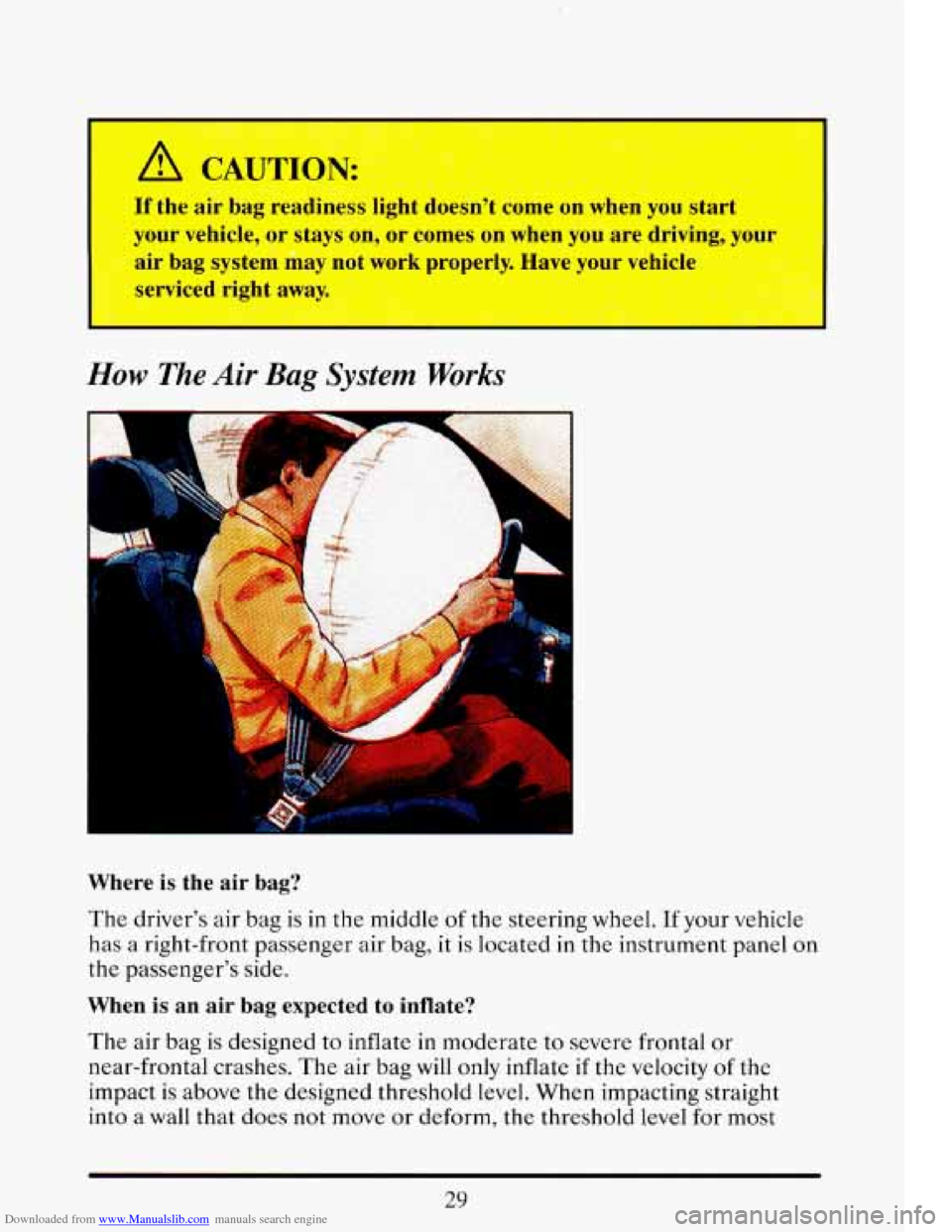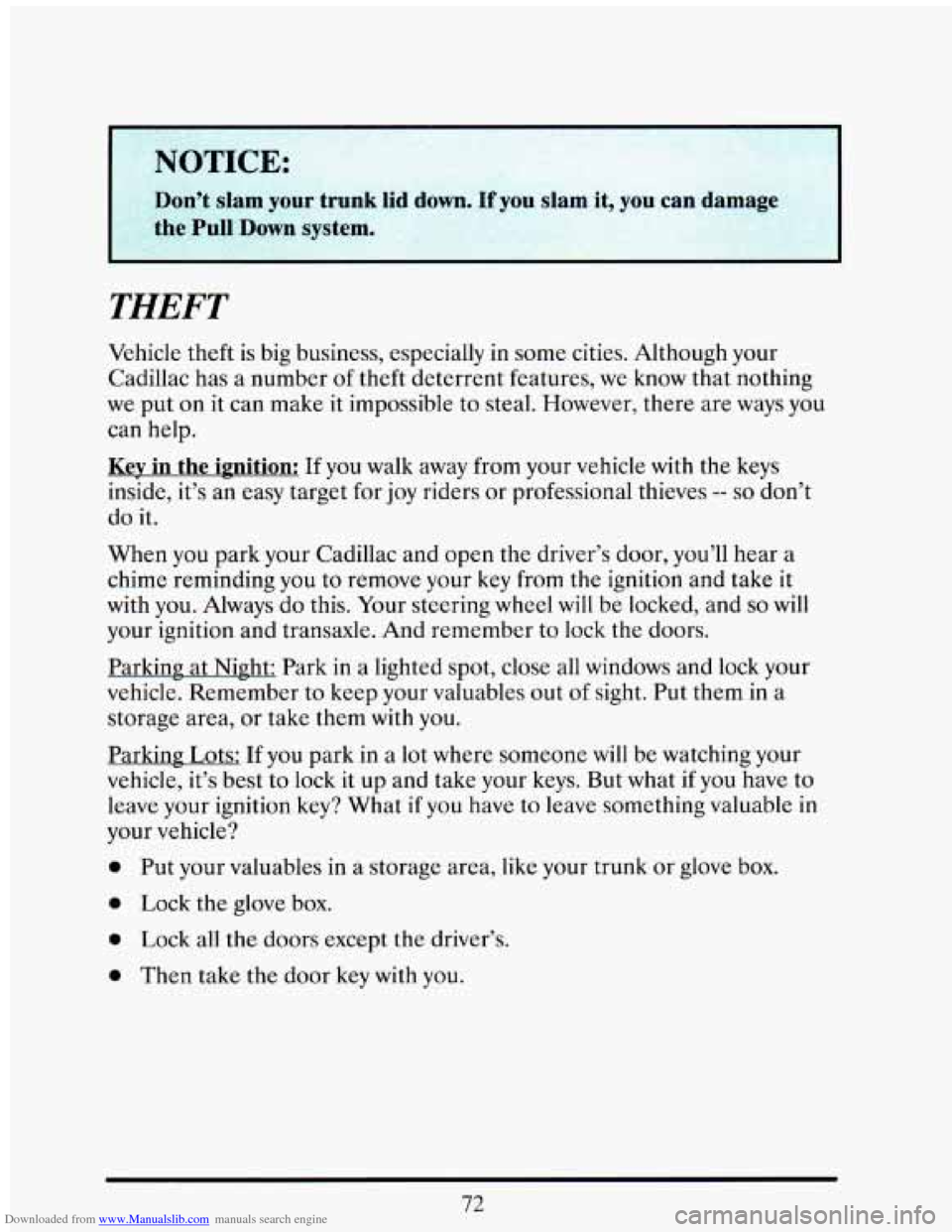1993 CADILLAC ELDORADO steering wheel
[x] Cancel search: steering wheelPage 9 of 398

Downloaded from www.Manualslib.com manuals search engine . .- 9 --r I I
r
r
P
-. . _.- , -. J. .-
For the 1948 model, Cadillac
introduced the legendary
tail fin
which set the trend in automotive
styling for nearly two decades. This
was followed
by the 1949 model with
the two door hardtop Coupe DeVille
and the modern overhead valve,
high compression
V8 engine.
-
Engineering innovations, con-
veniences and styling dominated the
'50s and '60s. Cruise control, auto-
matic climate control,
tilt and
telescoping steering wheels, twilight
sentinel and four door hard tops all
debuted in these years. In
1957 the
Eldorado Brougham featured ad-
vances such as air suspension, mem-
ory seat, automatic electric
door
locks, transistor radio, a brushed stainless steel roof
and low profile
tires.
introduced in
1953, was redesigned for 1967 as the
first front wheel drive personal lux- ury car. The
472 cu. in. V8 engine
used
in all Cadillacs in 1968 and
1969 was enlarged to 500 cu. in. for
all 1970 Eldorados.
An Air Cushion Restraint Sys-
tem (airbag) was available for
1974,
1975 and 1976 Cadillacs.
Analog Electronic Fuel Injec-
tion was available, on
1975 Cadillacs
and was standard on the new inter-
national size 1976 Seville. In 1978,
the Trip Computer option incor-
porated an on-board microprocessor.
Page 43 of 398

Downloaded from www.Manualslib.com manuals search engine I
How The Air Bag System Works
Where is the air bag?
The driver’s air bag is in the middle of the steering wheel. If your vehicle
has a right-front passenger air bag, it
is located in the instrument panel on
the passenger’s side.
When is an air bag expected to inflate?
The air bag is designed to inflate in moderate to severe frontal or
near-frontal crashes. The air bag
will only inflate if the velocity of the
impact
is above the designed threshold level. When impacting straight
into a wall that does
not move or deform, the threshold level for most
29
Page 44 of 398

Downloaded from www.Manualslib.com manuals search engine GM vehicles is between 9 and 14 mph. However, this velocity threshold
depends on the vehicle design and may be several miles-per-hour faster
or slower. In addition, this threshold velocity
will be considerably higher if
the vehicle strikes an object such as a parked car which will move and
deform
on impact. The air bag is also not designed to inflate in rollovers,
side impacts, or rear impacts where the inflation would provide
no
occupant protection benefit.
In any particular crash, the determination
of whether the air bag should
have inflated cannot be based solely on the level
of damage on the
vehicle(s). Inflation is determined by the angle
of the impact and the
vehicle’s deceleration,
of which vehicle damage is only one indication.
Repair cost is not a good indicator
of whether an air bag should have
deployed.
What makes an air bag inflate?
In a frontal or near-frontal impact of sufficient severity, sensors
strategically located
on the vehicle detect that the vehicle is suddenly
stopping as a result
of a crash. These sensors complete an electrical
circuit, triggering a chemical reaction
of the sodium azide sealed in the
inflator. The reaction produces nitrogen gas, which inflates a cloth bag.
The inflator, cloth bag, and related hardware are all part
of the air bag
inflator modules packed inside the steering wheel and in the instrument
panel in front of the passenger
if there is a passenger air bag.
How does an air bag restrain?
In moderate to severe frontal or near-frontal collisions, even belted
occupants can contact the steering wheel or the instrument pane\
l. The air
bag supplements the protection provided by safety belts. Air bags
distribute the force of the impact more evenly over the occupant’s upper
body, stopping the occupant more gradually. But air bags would not
provide protection
in many types of collisions, including rollovers and
rear and side impacts, primarily because an occupant’s motion is not
toward the air bag. Air bags should never be regarded as anything more
than a supplement to safety belt protection in moderate to severe frontal
and near-frontal collisions.
What will you see after an air bag inflation?
After the air bag has inflated, it will then quickly deflate. This occurs so
quickly that some people may not even realize that the air bag inflated.
The air bag
will not impede the driver’s vision or ability to steer the
30
Page 45 of 398

Downloaded from www.Manualslib.com manuals search engine vehicle, nor will it hinder the occupants from exiting the vehicle. There
will be small amounts of smoke coming from vents in the deflated air
bags. Some components
of the air bag module in the steering wheel hub
for the driver's
air bag or the instrument panel for the passenger's bag
may be hot for a short time, but the portion of the bag that comes into
contact
with you will not be hot to the touch. The nitrogen gas used to
inflate the air bag
will have vented into the passenger compartment, and
the
bag will be deflated within seconds after the collision. Nitrogen makes
up about
80% of the air we breathe and is not hazardous. As the nitrogen
vents from the bag, small particles are also vented into the passenger
compartment.
In many crashes severe enough to inflate an air bag, windshields are
broken
by vehicle deformation. Additional windshield breakage may
occur in vehicles with passenger air bags because the windshield acts as a
reaction surface
for the inflating air bag.
.. .i. ,<- -
Don't set anything on or attach anything to the instrument L;::,::.:;
': -2:
. _. - . ..
panel. It might injure the passenger if the air bag inflates.1-1.:6:..:.--r~ ._ -., :.<'.:.,..::--. ..-;; . ;:*
The air bags are designed to inflate only once. After thed .- G.-~~;,>.:i8
inflate, you'll need some new parts for your air bag system. If 'i2. 2:
you don't get them, the air bag system won't he there to help -.,is::,-:.::
protect you in another crash. A new system ,~.ill include air . -.
bag modules and possibly other parts .~~ p;. - . . -- :. - - -- - . - yj-;-.. ;c:=g.* - , :. .- .-
.- -. .: __ ..I . -, -- . .: .
- - $-.
.I , :>.:-
' : ~ :-- - .r- . Yx
~ .? : . .; _. r- I-. , -
. 2- *.:= ,,-L . . -- . . .-
Let
only qualified technicians work on your air bag system . - : -.- :.
Improper service can mean that your air bao cvctem wnn'fc--;- . ':.? >,
work properly. See your dealer for service.
..
:.. - . .. -- - .- .. ,, .. .. . - .- ~.
, . . .:---, , . . .- -- ., - ~ .. ,. -.
. .- - .. . .- , - - -. .. . .-- - ,. -.-
.. . .- ,. - .-x- - .. .
.. . .-
31
Page 86 of 398

Downloaded from www.Manualslib.com manuals search engine 1 NOTICE:
Don’t slam your trunk lid down. If you slam it, vou can damage
I
THEFT
Vehicle theft is big business, especially in some cities. Although your
Cadillac has a number of theft deterrent features, we know that nothing
we put on
it can make it impossible to steal. However, there are ways you
can help.
Key in the ipition: If you walk away from your vehicle with the keys
inside, it’s an easy target for joy riders or professional thieves
-- so don’t
do it.
When you park your Cadillac and open the driver’s door, you’ll hear a
chime reminding you
to remove your key from the ignition and take it
with you. Always do this. Your steering wheel will be locked, and so will
your ignition and transaxle. And remember to lock the doors.
Parking at Night: Park
in a lighted spot, close all windows and lock your
vehicle. Remember to keep your valuables out
of sight. Put them in a
storage area, or take them
with you.
Parking Lots: If
you park in a lot where someone will be watching your
vehicle, it’s best to lock
it up and take your keys. But what if you have to
leave your ignition key? What
if you have to leave something valuable in
your vehicle?
0 Put your valuables in a storage area, like your trunk or glove box.
0 Lock the glove box.
0 Lock all the doors except the driver’s.
0 Then take the door key with you.
72
Page 89 of 398

Downloaded from www.Manualslib.com manuals search engine If you lose or damage a PASS-Key I1 TM ignition key, see your Cadillac
dealer or a locksmith who can service PASS-Key
I1 TM to have a new key
made.
IGNITION KEY POSITIONS
This lock gives you five
different positions.
75
Before you put the key in, your ignition will be in the “LOCK” position.
This position locks your ignition, steering wheel and transaxle. It’s an
anti-theft feature.
Page 90 of 398

Downloaded from www.Manualslib.com manuals search engine The other positions let you perform these functions:
ACC: Accessory lets you use things like the radio and the windshield
wipers when the engine
is off. To get into “ACC”, push in the key and turn
it toward you. Your steering wheel will remain locked, just
as it was
before you inserted the key.
OFF This position lets you turn off the engine but still turn the steering
wheel. It doesn’t lock the steering wheel like
“Lock.” Use “Off” if you
must have your car in motion while the engine is off (for example, if your
car
is being pushed).
RUN: This
is the position for driving.
START
This starts your engine.
r
NOTICE:
If your key seems stuck in ‘ xk and you can’t turn it, be sure
it
is all the way in. If it is, then turn the steering wheel left and
right while
you turn the key hard. But turn the key only with
your hand. Using
a tool to force it could break the key or the
ignition swi’
’1. If none of this w--ks, then your vehicle 3
servi cc
STARTING YOUR ENGINE
Engines start differently. The 8th digit of your Vehicle Identification
Number
(VIN) shows the code letter or number for your engine. You will
find the VIN at the top left
of your instrument panel. (See “Vehicle
Identification Number” in the Index.) Follow the proper steps to start the
engine.
Move your shift lever to
“P” (Park) or “N” (Neutral). Your engine won’t
start in any other position
-- that’s a safety feature. To restart when you’re
already moving, use “N” (Neutral) only.
76
Page 94 of 398

Downloaded from www.Manualslib.com manuals search engine AUTOlMATIC TRANSAXLE
Your automatic transaxle may have either a shift lever located on the
steering column or
on the console between the seats.
There are
P.....
R ....
N ....
03 ....
3 .....
2 .....
1 .....
several different positions for your shift lever.
................................................ Park
............................................. Reverse
............................................. Neutral
........................................... Overdrive
........................................ SecondGear
........................................... FirstGear
................................... Third Gear (Drive)
P (Park)
This locks your front wheels. It’s the best position to use when you
start your engine because your vehicle can’t move easily.
80